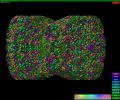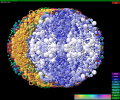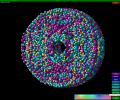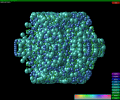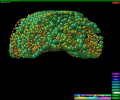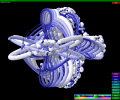Small history lesson
From time to time, a really nice software emerges from the binary depths of the program-developers' community. Sometimes this software is free and it becomes a "best-downloader"; more and more people like me and you, my readers, also download it to see what's all this fuss about and start loving it. Then it really transforms in a planetary-popular program, known from Alaska to Sri Lanka and from the vast ice-plains of Antarctica to the Norwegian fjords and everybody uses it.
And then what? People start to get bored of it and want something else or want more of it and so, plugins for awesomely popular softwares like Winamp come to life. And yes, it's another visual plugin for Winamp what I'll be talking about in this article. Something I've never encountered before, but which is truly addictive. Bubbles swirling around and changing shape, colored rings and massive whirlwinds which storm your desktop: Magic Iris is one new things that can be attached to Winamp.
The Looks & Works
Nice when it's windowed, even nicer when it's in the fullscreen mode, the Magic Iris is a "bubbly mess". A terrible swirl of both small and large 3D bubbles and small 3D rings being constantly generated one over another at speeds corresponding to the music you are listening to.
An almost furious tornado of particles as I never thought I'd see associated to Winamp, twisting, turning, rapidly changing colors and reshaping over and over again. A real madness, re-generating itself a couple of times per second with innumerable 3D bubbles of different sizes infinitely jumping, following a strange formula and creating almost "living" shapes. And when I said it is addictive, I really meant that: for some minutes both me and my colleague, the game-reviewer in our room, sat and watched several thousand life-cycles the crazy bubbles and rings completed.
The basic features of this visualization plugin are pretty OK for anyone who likes this kind of programs. Besides the tweaking in the registered version, there is also the option to save the results you produced and this is really nice: you can play as long as you want and when you obtain something that looks cool you just save it so you can reproduce the same things later.
Operating the Magic Iris is really easy: 10 buttons with explicit text on them indicate the possible actions and also help the user navigate the "sea" of storming bubbles. If you want to change the presets or the formula which governs the bubbling (yet ordered) mayhem, everything is done with just a mouse click.
The changes occur instantaneously, as you click the Magic Iris' buttons, and you can also return to a default "standard formula" with one click on the appropriate button. General use of Magic Iris is also made as simple as possible by means of a very nice feature: instead of having to click and cycle through numerous menus to set the colors you'd like to see in your visualization, you just draw a line in the palette area of this software. There are 4 different types of color-palettes, so you can virtually set the most unusual and even insane color-cycles for the twirling bubbles. From RGB standard-spread colors to preset cross-sections through the visual spectre, all you have to do is draw a line: all colors it passes through will be thus represented in the mass of 3D shapes. It simply can't get easier than this!
For even further variations, the Magic Iris sports a "mirror" button which (as I presume you've already expected) introduces very interesting mirrored movements among the bubble-storm. Combining all I've described so far with the power to automatically change both movement formula and presets, it's clear that one can produce a huge amount of ways in which the visualization reacts to music.
Far from being something out of the ordinary, the way Magic Iris works is - though very new - an interesting visual experience, which, I repeat, can become addictive. Even if some might find the storming bubble a tiring experience and an impossible-to-follow show, I'd say from my own past expertise that it indeed helped me relax. Watching for a few minutes the crazy amalgam and also setting different colors and motions for it can be a very nice and efficient method of relaxation, especially during working hours.
The Good
A different kind of visualization with a new approach on "showing" the music. For some Magic Iris will even become like a Solitaire or Minesweeper game: simple and slightly fun minutes spent way from the desk work's demands.
The Bad
The only bad thing is that you can't control the speed of the bubbly storm. Add this and some extra settings on dynamics and Magic Iris will definitely rock!
The Truth
Simple fun, almost like a kaleidoscope. Well worth its money.
Watch the snapshots below and see what Magic Iris is like:
 14 DAY TRIAL //
14 DAY TRIAL // 